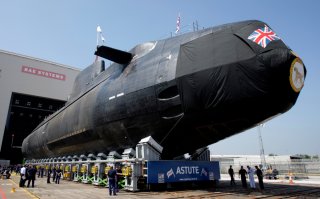Why Russia Is Afraid of the Royal Navy’s Next Submarine: The Astute Class
The Astute-class submarines are Britain's newest - and most dangerous - subs. But how would they fare in a war?
Here's What You Need To Remember: In any case, the Astutes are among the most formidable submarines in the world, and certainly pose a major threat to any Russian designs on the North Atlantic or the Arctic.
Since the commissioning of HMS Dreadnought in 1963, the Royal Navy has maintained a formidable force of nuclear attack submarines. Indeed, HMS Conqueror is the only nuclear attack submarine (SSN) to ever sink an enemy warship in anger. But the Royal Navy has undergone a transformational crisis over the past decade, shrinking in size and changing in composition. The latest nuclear attack subs, the Astute class, have become a critical component of the future of the Royal Navy—but, given Russia’s resurgence, are they enough?
Origin
The Royal Navy operated nineteen nuclear attack submarines across the course of the Cold War. As in the United States, the fall of the Soviet Union changed the requirements for the Royal Navy’s submarine fleet. The UK initially expected to build what amounted to Trafalgar Mark II boats: subs focused on antisubmarine warfare, expected to defeat Soviet submarines in the North Atlantic and the Arctic. But the collapse of the Soviet Union dramatically reduced the Russian sub threat, and created new requirements. The RN took a design pause, and eventually produced a larger submarine—one more suited to multipurpose operations, including land attack.
Recommended: America Has Military Options for North Korea (but They're All Bad)
Recommended: 1,700 Planes Ready for War: Everything You Need To Know About China's Air Force
Recommended: Stealth vs. North Korea’s Air Defenses: Who Wins?
HMS Astute was laid down in 2001, ten years after the completion of the last Trafalgar boat and three years after the launching of HMS Vengeance, the last of the Vanguard-class SSBNs. Unfortunately, the gap had led to the atrophy of key design and production capabilities, resulting in delays and cost overruns that continue to harry the program today. Basic drafting and engineering skills had deteriorated as the submarine construction work force had retired or moved on, forcing British Aerospace (which had taken over the program) to redevelop many key capabilities. Other problems emerged around the sophisticated drafting software used to design the class. This took time, pushing back the construction of the first boats, and pushing up overall costs.
Additional problems emerged after HMS Astute entered service. The boats are considered cramped, and crews have endured some atmospheric issues (excessive temperatures) inside the subs. Problems with reactor design (borrowed from the Vanguard SSBNs) led to a mismatch of some components, and an inability to achieve design speeds. To add insult to injury, HMS Astute ran aground on sea trials a month after its delivery.
Numbers
Notwithstanding these difficulties, HMS Astute entered service in August 2010, some nine years after being laid down. It was followed by HMS Ambush in 2013 and HMS Artful in 2016. HMS Audacious should enter service later this year, with Anson, Agamemnon and Ajax following at two-year intervals. Still, the Astutes represent a step back from a numerical perspective. From 1993 until 2004, the Royal Navy operated five Swiftsure-class SSNs and seven Trafalgars. The Swiftsures began to leave service in 2004, leaving the Trafalgars and the Astutes, which began to come into service in 2010. But the RN decided to retire the Trafalgars because of excessive hull wear beginning in 2009. Three of the boats remain in service, but by 2022 the Astutes will be the only nuclear attack submarines serving in the RN. In effect, the Royal Navy has gone from having a force of twelve SSNs to a force of seven SSNs, notwithstanding the greater size and capabilities of the Astutes.
Capabilities
The Astutes are the largest SSNs ever operated by the Royal Navy, half again as large as the Trafalgar class. At 7,700 tons, they are roughly the same size as the U.S. Navy’s Virginia-class boats, although smaller than the Seawolfs and the largest Russian SSN classes. The boats can carry thirty-eight missiles or torpedoes, and the Astutes are, along with the remaining Trafalgars, the only vessels currently in British service that can fire Tomahawk land-attack missiles. Unlike their American counterparts, the Astutes lack a vertical launch system (VLS) for their cruise missiles.
They are designed for thirty knots submerged, and although they initially suffered some problems, they reportedly have reached that speed in more recent trials. The Astutes carry an extremely effective sonar suite, generally believed to be as good or better than any competitor. And while information on relative acoustic signature of different submarines is hard to come by, authorities seem to regard the Astutes as among the world’s quietest boats.
Conclusion
Along with the two Queen Elizabeth–class aircraft carriers, the Astutes represent the core of the Royal Navy’s offensive capabilities. With the emergence of new tensions between NATO and Russia, they have regained the old antisubmarine mission, especially as Russian maritime interest has focused on rebuilding and recapitalizing the submarine fleet. The class seems to have overcome its technical and financial problems, although the lingering impact of those issues could affect not only future classes of SSNs, but also the UK’s commitment to building a new class of SSBNs. In any case, the Astutes are among the most formidable submarines in the world, and certainly pose a major threat to any Russian designs on the North Atlantic or the Arctic.
Robert Farley is a senior lecturer at the Patterson School of Diplomacy and International Commerce. His work includes military doctrine, national security, and maritime affairs. He blogs at Lawyers, Guns and Money and Information Dissemination and The Diplomat. Follow him on Twitter:@drfarls.
This article first appeared in 2018.
Image: Wikimedia Commons

